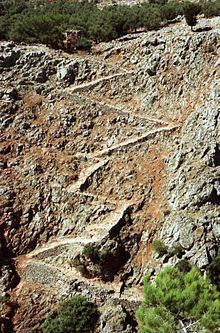 | ||
In the former Ottoman countries, a kaldırım (Turkish) or kalderimi (Greek καλντερίμι or καλντιρίμι; plural kalderimia) is a cobblestone-paved road built for hoofed traffic. Kalderimia are sometimes described as cobbled or paved mule tracks or trails.
Contents
Kalderimia are typically 1–1.5 m wide.
In Turkey, there existed urban kaldırımlar, notably the steep stepped Yüksek Kaldırım in Karaköy, Istanbul.
In Greece, the kalderimi network formerly linked almost every village, hamlet, chapel, and even sheepfold. These roads are paved with flat stones. As they are designed for foot and hoofed traffic, they have steps where necessary, made of stones laid vertically. On flat stretches, they may be unpaved. Kalderimia use switchbacks on steep ascents, and often have parapets next to steep slopes. When they cross streams, there may be paved fords.
The Skala of Vradeto (Greek: Σκάλα Βραδέτου) is a well-known kalderimi in the Epirus village of Vradeto used to enter the Vikos Gorge.
History
Kalderimia existed under the Ottoman Empire, and the name is Turkish, but it is not clear when they were first built. It is possible that, in Crete, they were originally Venetian roads.
Name
The name kalderimi comes from Turkish kaldırım 'pavement', from the verb kaldırmak 'to raise, erect'. Some sources derive it from Greek καλός δρόμος 'good road', while others regard this as unlikely.
